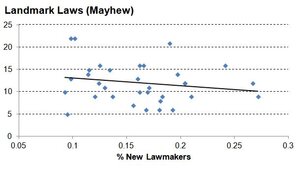Midterm elections: Why the logic of 'throwing the bums out' is wrong
When we look at the data, veteran lawmakers represent their constituents in much the same way as 'new' lawmakers.

This chart shows a negative relationship between landmark legislation and the percentage of new lawmakers in Congresses from 1947-2012. In other words, landmark legislation is less likely as the percentage of new lawmakers increases.
Rule 22
As the election season ramps up, Americans offer dozens of claims about the “problems” facing our country and their purported “solutions.” But while many of these claims are amenable to empirical scrutiny, few are ever studied.
Spoiler alert: Americans are lousy empiricists!
A recent post examined whether “career politicians” are “out of touch” which their constituents. According to a simple regression analysis, the answer is a resounding “no.” When we look at the data, veteran lawmakers represent their constituents in much the same way as “new” lawmakers.
In today’s post, we’re going to examine what is perhaps the most cited claim about how Americans can “fix” Congress: All we need are new lawmakers! According to this hypothesis, if we simply “throw the bums out,” the federal government will run better.
But while “throwing the bums out” is intuitive, there are good reasons why electing a large volume of new lawmakers is actually bad for Congress. I’ll get to that in a moment.
How can we examine this hypothesis? First, we need to define Congress’s “problems.” While it probably depends on who you ask, we can measure legislative performance using three intuitive constructs: (1) the number of laws enacted, (2) the size of the federal deficit, (3) Congress’s approval rating.
For laws passed, we can measure legislative accomplishment two ways. On the one hand, we may want to isolate “major” legislation. For this we can use data collected by David Mayhew (# landmark laws passed) and Joshua Clinton and Josh Lapinski (# significant bills passed). On the other hand, we may want to know about the fate of “all” bills. For this we can use data collected by Scott Adler and John Wilkerson (# bills passed). For budget deficits, the charts above use the total budget deficit or surplus divided by GDP. And for congressional approval, I’m using data from the American National Election Studies (ANES) on Americans’ level of “trust in government.”
With these data in hand, the rest is straightforward: Calculate the percentage of new lawmakers in a given Congress and examine the bivariate relationship with each measure of legislative performance. For laws enacted and trust in government, we are expecting a positively slopped line (increases in new members correlates with more legislation passed and higher overall trust) while for budget deficits we are expecting a negatively slopped line (increases in new members correlates with lower spending).
Here are the results. Each chart is for the 80th to the 112th Congresses (1947-2012).
- When we examine “major” enactments, we see a distinct negative relationship. (See the first two charts above: Landmark Laws and Legislative Accomplishment. Click the arrows to scroll through the charts.) While the relationship isn’t significant because of the limited sample size, the effect is substantively large. According to the data, a 10% increase in the percentage of new lawmakers decreases the number of landmark laws enacted by 3 and decreases the number of significant bills passed by 20.
- When we examine the total number of laws, however, the relationship is almost exactly zero. (Third chart above: Total Laws.)
- We see the same null relationship with budget deficits: large changes in the percentage of new lawmakers has virtually no effect on the overall budget. (Fourth chart above: Budget Deficit)
- Finally, there is a small negative relationship with trust in government. As the number of new lawmakers increases, there is a minor decrease in the number of Americans saying they trust the federal government. (Fifth chart above: Trust in Government.)
So in summary, not only is there no improvement in Congress’s job performance when a large volume of new lawmakers are voted into office, but, if anything, there is a modest negative relationship. Contrary to the conventional wisdom, therefore, it would seem that “throwing the bums out” negatively impacts Congress’s job performance.
What explains this negative effect? While not directly examined here, there are good reasons to suspect that political polarization is at fault. As we documented in this post, polarization is caused in large part by the replacement of old members with new members. In fact, according to political scientist Sean Theriault’s excellent book, Party Polarization in Congress, about two-thirds of the increase in Congress’s polarization is due to new members.
As an example, imagine that tea party-backed state Sen. Chris McDaniel had defeated six-term US Sen. Thad Cochran in Mississippi’s contentious GOP primary. Would McDaniel have “fixed” Congress, or contributed to its further polarization and gridlock? While this is just one race, it represents the larger trend over the past 30 years.
In sum, when you “throw the bums out,” you actually increase Congress’s polarization which, in turn, has negative consequences for the institution’s overall performance.
Finally, let me just clarify that wanting to throw the bums out is not misplaced. Arguably, Congress deserves its negative rating. Nonetheless, flooding the institution with new members won't solve the underlying problem. It’s important to keep our eye on what matters.
Jordan Ragusa publishes his Rule 22 blog at http://rule22.wordpress.com/.

